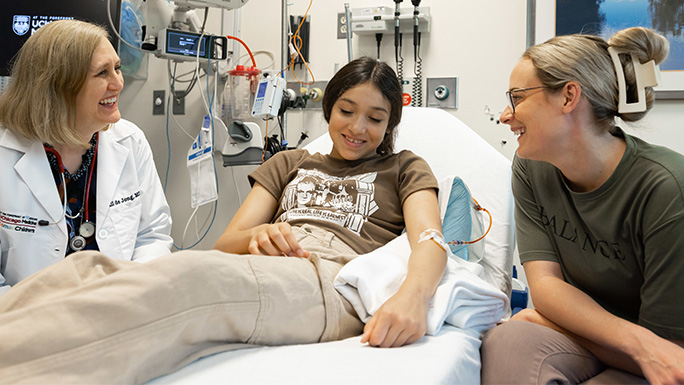Neutropenia in Children

Neutropenia is a rare blood disorder that results in an abnormally low level of neutrophils. Neutrophils are white blood cells that are the body’s main defense against bacterial and fungal infections. In children, neutropenia can increase the risk of frequent, life threatening infections due to the body's inability to fight off bacteria.
Hematologists at UChicago Comer Children's are experts at diagnosing and treating neutropenia in children of all ages. As part of our comprehensive approach, we help during every step — from initial testing to continuous treatment to staying healthy through adulthood.
What are Abnormal Levels of Neutrophils?
Children with neutropenia have an absolute neutrophil count (ANC) of less than 1500/uL. The ANC is usually gathered from a complete blood count (CBC), which is a common type of blood test.
- Mild neutropenia is 1000-1500 cells/uL
- Moderate neutropenia is 500-1000 cells/uL
- Severe neutropenia is <500 cells/uL

Why Choose UChicago Medicine for Treating Your Child's Neutropenia?
A multi-disciplinary team of experts: Our hematologists, nurses, and stem cell specialists collaborate seamlessly to provide personalized, advanced care.
At the forefront of neutropenia research: Our Comer Children's physician-scientists are working to develop new therapies that focus on new protocols for the most up-to-date treatments.
A comprehensive approach: Besides our clinical care, we offer counseling and support from psychologists, social workers, and child life providers to address concerns and stress that may accompany chronic illness.
Frequently Asked Questions About Neutropenia in Children
What are the types of neutropenia in children?
Congenital neutropenia: These rare types of neutropenia are present from birth and are inherited. Genetic mutations affecting the production, function or survival of neutrophils cause congenital neutropenia in children. Some of the types of congenital neutropenia include:
- Kostmann’s syndrome and Severe Congenital Neutropenia: Associated with very low neutrophil count and frequent infections usually identified in the first year of life.
- Shwachman Diamond syndrome: Neutropenia associated with improper functioning of the bone marrow and problems with the pancreas.
- Cyclic neutropenia: This is a rare form of neutropenia characterized by periodic changes in the number of neutrophils in the blood. Children with cyclic neutropenia may have improved neutrophil count after puberty.
Autoimmune neutropenia: This type occurs when the body’s immune system destroys neutrophils.
Chronic benign neutropenia of childhood: This type occurs when children consistently have a low absolute neutrophil count but do not have any severe infections. It is the most common form of neutropenia for children under age four.
Most patients recover normal neutrophil counts by 5 years of age, but neutropenia can persist for months or even years before recovery. Children are at risk for bacterial infections, and even sepsis, so it’s important to seek medical care in the event of a fever.
Duffy phenotype: Some people have an absolute neutrophil count that is lower than average, but they are not at risk for infection. This is due to a genetic variant, Fy(a-b-) that is protective against malaria. A lab test can determine if this variant is present. There is no treatment needed.
What are the signs or symptoms of neutropenia in children?
Signs or symptoms of neutropenia in children can vary depending on the cause and severity. Many children with neutropenia develop infections easily because of their abnormally low white blood count.
Common symptoms include the following:
- Recurrent or prolonged infections
- Fever
- Poor wound healing
- Mouth ulcers or gingivitis
- Fatigue or weakness
- Swollen lymph nodes
- Diarrhea or loose bowels
- Pain during urination
How is neutropenia in children diagnosed?
Children can inherit neutropenia at birth or acquire it. Your child's physician will order a blood test, a CBC with differential, that measures the absolute neutrophil count. The doctor will also ask about any medications taken recently or recent infections that could cause a low white blood cell count.
Some children need a bone marrow biopsy, where a small amount of bone marrow is removed to test for disease. This test can look for underlying causes of neutropenia, such as malignancies or genetic disorders.
What causes neutropenia?
Various underlying conditions, including inherited disorders, cancer, infections, autoimmune diseases and certain medications cause neutropenia in children. These include:
- Autoimmune issues, such as lupus, where the child's immune system mistakenly attacks and destroys their own neutrophils
- Medication, like chemotherapy
- Cancer in the blood, like leukemia
- Some children inherit neutropenia due to genetic mutations affecting white blood cell count.
- Bone marrow failure syndromes
- Other diseases that take over the bone marrow space so that neutrophils are not able to be produced normally
How is neutropenia in children treated?
Treatment for neutropenia in children will depend on the underlying cause. Antibiotics help fight off infection in the setting of low absolute neutrophil count, and sometimes medications are given to help the bone marrow produce more neutrophils.
Your child's treatment may include the following:
Antibiotics: To fight off infections caused by low neutrophils, the physician may prescribe antibiotics or modify current medication doses. Preventive antibiotics may also be prescribed to try to prevent infections. Frequent use of antibiotics over time can cause side effects like diarrhea.
Immune-enhancing drugs: Growth factors G-CSF or GM-CSF are used to treat some children with severe neutropenia who have frequent infections. They stimulate the production of neutrophils, which increases their numbers in the bloodstream.
Bone marrow transplant: This treatment involves replacing insufficient bone marrow with healthy bone marrow from a matched donor. It is not typically the first line of treatment for neutropenia in children.
Fevers with neutropenia
Children with neutropenia are at risk for life threatening infections, including sepsis. Fevers can be caused by a viral infection, which is not dangerous for most patients with neutropenia. However, fevers from bacteria or fungus infection can be very dangerous.
Neutropenic fever greater than or equal to 100.4 F (38 C) for at least an hour is considered a medical emergency. Patients with fever should seek medical care immediately to have blood counts and blood culture checked. Sometimes the neutrophil count may increase in the setting of a fever, but if the neutrophil count is low, then IV antibiotics should be given quickly in order to prevent sepsis.
Meet our Neutropenia in Children Experts

Pediatric Hematology & Oncology (Pediatric Cancer)

Pediatric Hematology & Oncology (Pediatric Cancer)

Pediatric Hematology & Oncology (Pediatric Cancer)

Pediatric Hematology & Oncology (Pediatric Cancer)

Pediatric Hematology & Oncology (Pediatric Cancer)

Pediatric Hematology & Oncology (Pediatric Cancer)
Request an Appointment for Pediatric Blood Disorders
We are currently experiencing a high volume of inquiries, leading to delayed response times. For faster assistance, please call 773-702-6808 to schedule your appointment.
If you have symptoms of an urgent nature, please call your doctor or go to the emergency room immediately.
For Referring Physicians
To refer a pediatric patient, please call UCM Physician Connect at 1-800-824-2282.
* Indicates required field
